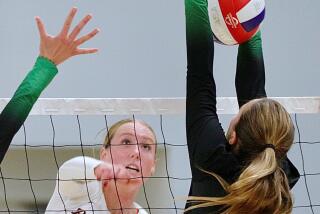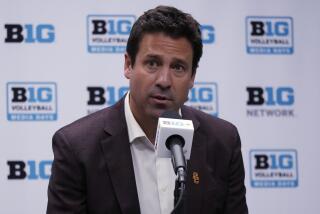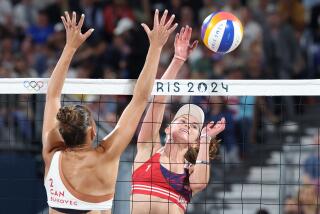U.S. Volleyball Grows on the Farm : B Team Gives Women Introduction to National Program
- Share via
SAN DIEGO — Terry Liskevych was in South Korea in March, 1985. He probably would have preferred to be anyplace else.
Liskevych assembled a group of women college players, disguised it as the U.S. national team and took it to South Korea for a five-match series against a club team, which was not to be confused with the South Korean national team.
Liskevych watched as the United States won one game in the five matches. If there was ever a time to consider Plan B, this was it. Unfortunately for Liskevych and the U.S. volleyball program, there was no Plan B.
Now there is.
After that embarrassing episode, Liskevych vowed that it would not happen again. He set out to put together a B team, sort of a minor league team that would feed into the national team.
“When I took the job, I made myself a promise,” Liskevych said. “I would not leave the team in the shape I received it in.”
Liskevych was named the U.S. women’s volleyball coach after the 1984 Olympics. Nearly the entire roster, including starters and coach, left en masse after the Americans won the silver medal.
Liskevych took on not only the job of rebuilding the national team but also the national program. To do that, he was convinced that there would have to be a “junior varsity.”
Three years have passed since the Korean trip, and Liskevych finally has his B team. Fifteen athletes have been learning the U.S. brand of volleyball since June 12 in San Diego. The players are practicing twice a day--once at the Federal Building in Balboa Park and once at UC San Diego--until Tuesday.
The team will play the West German national team tonight at 7 at Torrey Pines High School and Thursday at 7 p.m. at Carlsbad High.
The players are a mix of some who have recently finished their college eligibility and others who are still competing in college. The goal is the 1992 Games.
Suzanne Eagye, who recently completed her college eligibility, is the only San Diego area player. She graduated from Point Loma High and played four years at Hawaii, leading the Rainbow Wahines to the NCAA title this past season.
Eagye has a tougher road than younger players who will still compete on the college level. Outside of club volleyball, which is a far cry from international play, out-of-college athletes must discipline themselves to stay in shape and work on their games.
Eagye, who made the B team as an alternate when another player decided not to attend, said she will have the benefit of working out with the Hawaii team next year while she finishes her degree.
“It’s easy not to work out when you don’t have a goal in mind,” Eagye said. “I played on a club team, but I don’t think I put my heart and soul in it because I didn’t see what was ahead.”
Ahead now is a shot at the national team. Before the B team, the only other recourse would have been to try out for the national team, a difficult task when one doesn’t have a chance to learn or even see the team’s system. Eagye’s chances probably would have been slim.
At least now she can work inside the national program and learn what it takes.
“You’re playing with some great players, and you’re learning a lot,” Eagye said. “You have to push yourself as hard as you can and beat out the other players.”
Lonise Norfleet, a 6-foot 2-inch outside hitter, just finished her freshman year at USC. The coaches think she has potential, and the B team gives her an opportunity to prove it.
“It’s part of my dream,” Norfleet said. “I want to play in the Olympics. This is my steppingstone to get there.”
Eagye and Norfleet are among the players culled from an extensive search for talent by Liskevych and the coaching staff.
The original selection process started with Liskevych sending 30 coaches a list of 50 of the top college players. The coaches ranked them in order, and the coaching staff selected 20 names. Liskevych took this list to eight coaches he respected highly and asked their opinions.
He was just as careful in selecting the coaches. Mike Hebert of Illinois heads the B team and is assisted by Shelton Collier of Pittsburgh, Terry Pettit of Nebraska and Sue Gozansky of UC Riverside. Liskevych said he has known each for at least 16 years.
Liskevych hopes to expand; he said that next year, he wants to have the team practice for a month.
“Eventually, we want many more than 15 players, possibly 24, “ Liskevych said. “It would be nice to have a B team that will train full time.”
But costs are prohibitive. Each player had to supply her own transportation and pay $500 toward her expenses while staying at USD. Most of the players had their $500 fees paid by their schools, which Liskevych said was approved by the NCAA.
Liskevych said he hopes that eventually the B team will play internationally. But he said that outside of the general housing and transportation expenses, it costs between $30,000 and $40,000 to take a team for a week on tour to Europe or Asia.
Although the B team program is a relatively new concept in the United States, it is common practice in the rest of the world. And countries with strong club programs have traditionally done well in international events.
Plans are for tying the B team to the World University Games team, which will compete in August of next year in Rio de Janeiro. In the past, players got together for maybe two weeks of practice before they departed for the games.
“We always throw our kids to the wolves,” Liskevych said. “The top six spots at the World University Games (in 1987) went to countries that had national (college-age) teams.
“In 12 to 16 years, I envision volleyball to be very similar to men’s and women’s basketball. We would be able to choose a team in an Olympic year and practice in the summer. Players from Japan and the Soviet Union, for example, play five to six months on clubs and then the rest of the time on the national team.”
Liskevych said he doesn’t expect that B players will move on to the national team en masse. But it is a way to see whether an athlete will adapt to the national program. Eventually, when a player moves up to the national team, she already will have international experience.
“Out of 15, if four make it to the national team, then we’ve done well,” Liskevych said. “I want to not only build a good team. I want to build a good program.”
More to Read
Go beyond the scoreboard
Get the latest on L.A.'s teams in the daily Sports Report newsletter.
You may occasionally receive promotional content from the Los Angeles Times.






